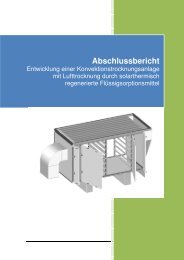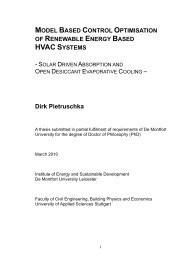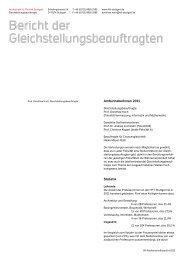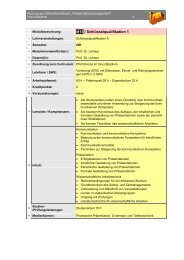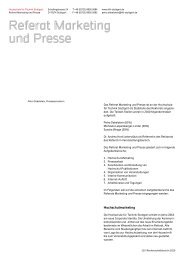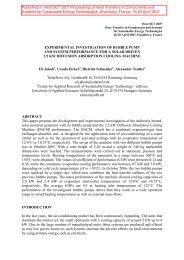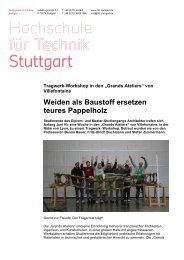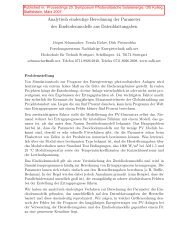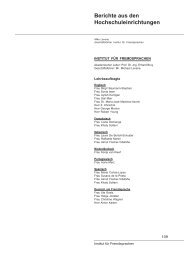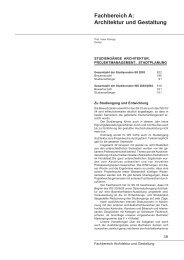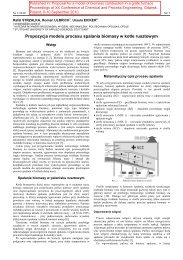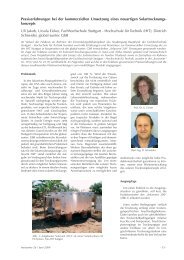The GIS-based energy consumption of the buildings ... - HFT Stuttgart
The GIS-based energy consumption of the buildings ... - HFT Stuttgart
The GIS-based energy consumption of the buildings ... - HFT Stuttgart
Create successful ePaper yourself
Turn your PDF publications into a flip-book with our unique Google optimized e-Paper software.
1 INTRODUCTION<br />
<strong>The</strong> <strong>GIS</strong>-<strong>based</strong> <strong>energy</strong> <strong>consumption</strong><br />
<strong>of</strong> <strong>the</strong> <strong>buildings</strong> in Scharnhauser Park<br />
MSc. Aneta Strzalka, Pr<strong>of</strong>. Dr. Ursula Eicker<br />
<strong>Stuttgart</strong> University <strong>of</strong> Apllied Sciences<br />
Schellingstr. 24<br />
70174 <strong>Stuttgart</strong>, Germany<br />
<strong>The</strong> research work described in this paper is a part <strong>of</strong> an international research project c<strong>of</strong>unded<br />
by <strong>the</strong> European Commission called POLYCITY, which is coordinated by <strong>the</strong><br />
<strong>Stuttgart</strong> University <strong>of</strong> Applied Sciences. <strong>The</strong> test area is <strong>the</strong> residential area Scharnhauser<br />
Park close to <strong>Stuttgart</strong>.<br />
This paper describes <strong>the</strong> applicability <strong>of</strong> <strong>GIS</strong>-technology for improving <strong>the</strong> <strong>energy</strong><br />
management <strong>of</strong> urban areas. In order to achieve it, <strong>the</strong> <strong>energy</strong> related data <strong>of</strong> Scharnhauser<br />
Park was collected, analyzed, visualized and published via Internet. <strong>The</strong> main aim <strong>of</strong> this<br />
project is to find potential <strong>energy</strong> savings. <strong>The</strong> web application shall contribute to <strong>the</strong><br />
improvement <strong>of</strong> sustainable urban development and encourage o<strong>the</strong>r municipalities to realize<br />
similar projects.<br />
2 METHODOLOGY<br />
2.1 Data acquisition<br />
2.1.1 Energy <strong>consumption</strong> data<br />
<strong>The</strong> <strong>energy</strong> <strong>consumption</strong> data <strong>of</strong> all <strong>buildings</strong> <strong>of</strong> Scharnhauser Park originate from <strong>the</strong> archive<br />
<strong>of</strong> <strong>the</strong> municipal utility company Esslingen am Neckar GmbH and from <strong>the</strong> Energy Baden-<br />
Württemberg AG (EnBW). This data are annual heating and electricity <strong>consumption</strong> data for<br />
each building in form <strong>of</strong> Excel or paper sheets. In order to organize <strong>the</strong>se data, a data model<br />
was developed and implemented in an Access database.<br />
2.1.2 Spatial data<br />
<strong>The</strong> project POLYCITY was provided with a map <strong>of</strong> Scharnhauser Park from <strong>the</strong> city <strong>of</strong><br />
Ostfildern. This map is a DXF-file and contains all dimensions and object information for <strong>the</strong><br />
analyzed residential area, e.g. building name, street name, house number.<br />
2.2 <strong>GIS</strong> – application<br />
In order to be able to visualize and analyze <strong>the</strong> data <strong>of</strong> Scharnhauser Park, <strong>the</strong> products <strong>of</strong><br />
GeoMedia s<strong>of</strong>tware family were used. <strong>The</strong> program GeoMedia Pr<strong>of</strong>essional has a capability<br />
to directly access spatial data in different vendor formats and <strong>the</strong>refore use it by visualizing<br />
and analyzing it. GeoMedia WebMap Pr<strong>of</strong>essional was used to build a geospatial web<br />
application, which provides access to geospatial data. <strong>The</strong> next picture shows <strong>the</strong> workflow<br />
for collecting, visualizing, analyzing and publishing all project related data.
Picture 1: Scheme <strong>of</strong> using <strong>GIS</strong> technology for <strong>the</strong> analysis <strong>of</strong> project related data<br />
Energy data<br />
(Excel and paper sheets)<br />
Database<br />
(Access)<br />
Building data<br />
GeoMedia Pr<strong>of</strong>essional<br />
GeoWorkspace<br />
(GWS)<br />
Web Map Service<br />
(WMS)<br />
GeoMedia Web Map<br />
Pr<strong>of</strong>essional<br />
Spatial data<br />
(DXF – file)<br />
Database<br />
(Access)<br />
Spatial data<br />
POLYCITY-<br />
Website<br />
Publication<br />
<strong>The</strong> collected attribute and <strong>energy</strong> <strong>consumption</strong> data were stored in an Access database. <strong>The</strong><br />
spatial data from <strong>the</strong> DXF-file were visualized in a GeoWorkspace, where <strong>the</strong>y were<br />
automatically transferred into a new Access database. <strong>The</strong> program GeoMedia Pr<strong>of</strong>essional<br />
was used to join <strong>the</strong> spatial data with <strong>the</strong> attribute and <strong>energy</strong> <strong>consumption</strong> data by <strong>the</strong><br />
building ID. This operation enabled to visualize <strong>the</strong> <strong>energy</strong> <strong>consumption</strong> data in a number <strong>of</strong><br />
<strong>the</strong>matic maps, where <strong>the</strong> color indicates <strong>the</strong> degree <strong>of</strong> <strong>energy</strong> <strong>consumption</strong>.<br />
Picture 2: <strong>The</strong>matic map <strong>of</strong> <strong>the</strong> annual heating <strong>energy</strong> <strong>consumption</strong> <strong>of</strong> 2008<br />
Fur<strong>the</strong>r on, <strong>the</strong> program GeoMedia Web Map Publisher was applied for publishing <strong>the</strong><br />
<strong>the</strong>matic maps in Internet via a Web Map Service (WMS), incl. an appropriate user interface.<br />
This WMS was finally implemented in <strong>the</strong> POLYCITY – website to publish all project related<br />
data via Internet.<br />
3 RESULTS<br />
<strong>The</strong> visualization and analysis <strong>of</strong> <strong>the</strong> <strong>energy</strong> <strong>consumption</strong> data in a GeoWorkspace showed<br />
significant differences between values within one building type. For example, <strong>the</strong> standard<br />
deviation <strong>of</strong> <strong>the</strong> average value for <strong>the</strong> heating <strong>energy</strong> <strong>consumption</strong> by <strong>the</strong> building type J is up<br />
to 40 % (Picture 3). This shows possible savings in <strong>the</strong> <strong>energy</strong> <strong>consumption</strong> <strong>of</strong> <strong>the</strong> <strong>buildings</strong><br />
by changing <strong>the</strong> user behavior.
Picture 3: Average values for <strong>the</strong> annual heating <strong>energy</strong> <strong>consumption</strong> 2006 for different<br />
building types<br />
Heating <strong>energy</strong> <strong>consumption</strong> in kWh/m²<br />
90<br />
80<br />
70<br />
60<br />
50<br />
40<br />
30<br />
20<br />
10<br />
0<br />
A B C D E F G H I J K L M N O P R S T A-T<br />
Building type<br />
Average value Standard deviation<br />
Within <strong>the</strong> implementation <strong>of</strong> <strong>the</strong> developed WMS interface into <strong>the</strong> POLYCITY-website,<br />
users can have a possibility to access this web portal in order to evaluate <strong>the</strong> status <strong>of</strong> <strong>the</strong>ir<br />
<strong>energy</strong> <strong>consumption</strong>. Regarding data privacy protection, only <strong>the</strong> average annual <strong>energy</strong><br />
<strong>consumption</strong> data for each building type have been published.<br />
Picture 4: POLYCITY Web <strong>GIS</strong>-Application (Heating <strong>energy</strong> <strong>consumption</strong> 2008)<br />
Source: POLYCITY-Website<br />
4 CONCLUSIONS<br />
<strong>The</strong> research work described in this paper and carried out within <strong>the</strong> project POLYCITY is an<br />
example for sustainable management <strong>of</strong> urban areas. This analysis was mostly <strong>based</strong> on<br />
<strong>energy</strong> <strong>consumption</strong> data <strong>of</strong> all <strong>buildings</strong> in <strong>the</strong> residential area Scharnhauser Park. <strong>The</strong><br />
results <strong>of</strong> this analysis showed a high potential for reducing <strong>the</strong> <strong>energy</strong> <strong>consumption</strong> <strong>of</strong><br />
<strong>buildings</strong> and <strong>the</strong>refore reducing <strong>the</strong> CO2-emissions. <strong>The</strong> implementation <strong>of</strong> <strong>the</strong> developed<br />
<strong>GIS</strong>-application into <strong>the</strong> POLYCITY-website gives all users a possibility to show <strong>the</strong> <strong>energy</strong><br />
information <strong>of</strong> <strong>the</strong>ir <strong>buildings</strong>. <strong>The</strong> in this research work presented concept <strong>of</strong> web-<strong>based</strong> <strong>GIS</strong>application<br />
can serve as a model for o<strong>the</strong>r similar communities to support <strong>the</strong> sustainable<br />
<strong>energy</strong> management.



